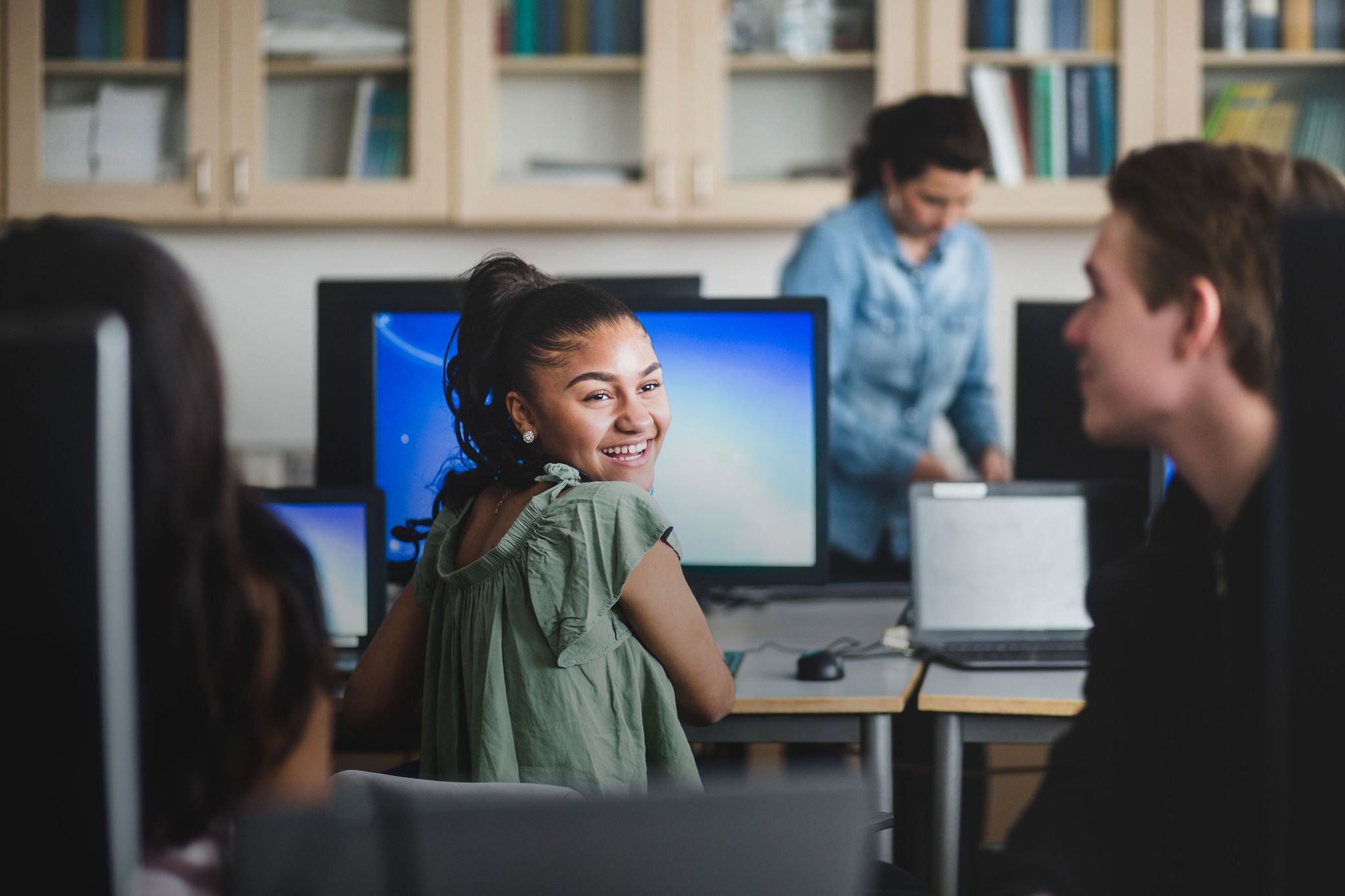EY refers to the global organization, and may refer to one or more, of the member firms of Ernst & Young Global Limited, each of which is a separate legal entity. Ernst & Young Global Limited, a UK company limited by guarantee, does not provide services to clients.

Digital tools and capabilities in the hands of teachers in low-income countries help to empower and support future leaders.
In brief
- As low-income countries work to close the learning gaps exacerbated by pandemic school closures, digital capabilities are important tools to build back better.
- Teachers need new digital infrastructure and re-training to run effective digital classrooms, quality resources and new content around future-focused topics.
- Organizations can support these needs by bringing their digital and future-skills expertise to collaborate with teachers and schools.
The COVID-19 pandemic resulted in a tremendous shock to global education and learning, as schools closed, and students were sent home. In high-income countries the impact was mitigated to a degree by more abundant broadband and greater access to home or school computers. But, for many low-income countries, school closures were a catastrophe. In 2020, UNESCO data showed only 54% of low-income countries provided distance learning during school closures, compared with 91% of high-income countries where online classes were routinely offered as an alternative to in-school learning.
Not surprisingly, research shows the largest learning losses were suffered by children in low-income countries. According to The World Bank’s latest publication, The State of Global Learning Poverty: 2022 Update, learning poverty has increased by a third in low- and middle-income countries, with an estimated 70% of 10-year-olds unable to understand a simple written text – up from 57% before the pandemic.
As low-income countries seek to close their education gaps, private organizations and non-profits have important roles to play. The opportunity is not just to improve literacy rates but to offer a future-focused curriculum and upskill teachers to use blended learning, combining face-to-face teaching with online instruction, to help students in low-income countries rise out of poverty.
Across the 60 organizations that comprise Teach For All, a global network developing promising future leaders to teach in their nations’ under-resourced schools and communities, the pandemic sparked powerful innovations by teachers who used technology to ensure their students continued to learn, even in communities with low or no connection to the internet. Leveraging technology to improve education and expand opportunity is an important way the partners in the Teach For All network are supporting students to shape a better future for themselves and the world around them.
EY’s ambition to build a next generation workforce is focused on giving young people and underserved groups the skills to do just that. Working from the premise that tomorrow’s workers will need to be creative, adaptable, and resilient, EY teams work with young people and underserved groups to foster future-focused mindsets and build the appropriate skillsets for tomorrow.
Together, EY and Teach For All have been collaborating to develop a digitally capable generation of teachers delivering learnings grounded in the real needs of students. The resulting programs address challenges such as limited access to strong virtual materials, curriculum gaps in future skills and a lack of teacher training to deliver fully digital or hybrid learning.
Chapter 1
Modernizing the curriculum and teaching practices
Contemporary content and digital classrooms support students to succeed in the future of work.
Introducing teachers to future skills learning modules
In its 2021 paper, Equity and quality in education, the Organisation for Economic Co-operation and Development (OECD) states that schools should aim to provide students “with knowledge, skills and interpersonal competencies required for their development, adult life and contributions to economy and society.”
Mindful that schools need to prepare students for future jobs that require new skillsets, EY teams have developed EY Future Skills Workshops, covering future-focused topics not always taught in schools, with options for digital delivery. Topics include environmental sustainability, emerging technology, civic literacy, financial literacy and more. By inspiring students between the ages of 5 to 22 to explore these topics, the workshops aim to help young people unlock new passions, explore potential career paths, and develop the mindsets and skills needed for the future working world.
Initially, these workshops were led by EY professionals, but now the program is scaling significantly and being offered in both synchronous (students and teachers are in the same physical or virtual place) and asynchronous (self-paced learning) formats.
For example, asynchronous text message-based courses are now available, distilling EY Future Skills Workshop modules on entrepreneurship into bite-size learning, provided via daily text messages. These text-based courses, now accessible to anyone with a mobile phone, have already had 10,000 completions in eight countries.
To scale synchronous delivery, EY volunteers collaborated with Teach For Lebanon to train 82 teachers to deliver Future Skills Workshop modules to their students, including high-need groups like refugees. The Teach For Lebanon teachers are now to deliver Future Skills content autonomously to their students, already reaching more than 3,600 students across the country.
Two of these teachers, David and Loreen, are now equipped to teach modules on Diversity and Inclusion and Emerging Technologies. Talking about the latter, David said, “EY left us with great knowledge about the emerging technologies of our time. Helping our students gain insight into these emerging technologies is essential in an ever-changing world.” As a computer and technology teacher, Loreen found this session very relevant: “The session demonstrated tools available for free with engaging animations tackling recent and complicated topics about technology that are simplified, easy to use and appealing to the students.” Loreen was also impressed with the materials on Diversity and Inclusion, “The session introduced us to easily accessible and detailed materials that can make our experience as teachers with such topics easier and more entertaining for students.” David agreed, explaining, “I think no better words can describe our society in Lebanon. One common mistake we make is ignoring diversity. EY highlighted the importance of diversity and inclusion and how to be aware of it in our classrooms to create a safe and collaborative learning environment.”
Scaling digital learning training programs for teachers
To help teachers get quickly oriented with the new skills required in an online classroom, Teach For All network partner, Enseña Perú, co-created an online training module alongside current teachers using insights and real-world examples from digital classrooms across the country. The training was delivered to thousands of teachers across Peru, serving as a blueprint for how to train teachers at scale.
Teachers were highly satisfied with the virtual training module. In addition to attending the sessions, they received personalized feedback, simulations, access to professional learning communities, lectures and further reading. Graduates of the program are now weaving videos, audio clips and pictures of students’ work into their regular teaching practices.
Since the beginning of the COVID-19 pandemic, the Philippines' education system has been upskilling teachers to adapt to hybrid teaching and learn to be effective in a digital classroom. To support this, Teach for the Philippines supported free training for public school teachers in digital literacy, blended learning and 21st century education models. Building on this, Teach for the Philippines is now implementing a series of training sessions for teachers and parents on digital literacy and responsible digital citizenship.
Chapter 2
2 Chapter 2 Empowering teachers to create and share educational materials
Lesson banks, new instruction models and digital platforms accelerate learning improvements at scale.
Co-creating digital instruction materials with teachers
In response to school closures during the pandemic, the 321 Foundation, founded by Teach For India alumnus, Gaurav Singh, worked with 1,000 schools, 15,000 teachers and 300,000 students to deliver CAPE, a free online lesson bank optimized for use on basic devices and where there is limited data connectivity. CAPE includes tried and tested videos, pictures, worksheets, and activities packaged as one-page lessons that can easily be shared via SMS text messages and are aligned to central and state board standards.
Reflecting on the new resources now available to his faculty, Mohammed Azharuddin, a school leader in Hyderabad said, “CAPE has provided us with free, high-quality content, which is also engaging, well-structured, intuitive and easy to follow for both teachers and students. It has also solved the problem of providing depth to asynchronous teaching.”
Since its launch, CAPE has helped 321 expand from a presence in 70 schools in three cities to over 600 schools in eight major cities and numerous smaller towns. Beyond the pandemic, the plan is to continue using CAPE as a supplement to in-school instruction.
In Pakistan, where many students lack internet access at home, Teach For Pakistan teachers developed a full model of instruction to be conducted over text messages on mobile phones. In “Text School”, teachers created SMS content and sent learning packets home. Students took pictures of their work and sent it for feedback. Soon pupils were sending their questions over voice notes and class discussions started to flow. With the ability to ask follow-up questions over the app, students got individual attention they hadn’t received in a busy class of 50 students. Eventually, they started using the groups to talk to each other during non-class hours, sustaining social connection during lockdown.
The strategy has increased both parental involvement in their children’s studies and student agency. When schools reopened, teachers took Text School back into their classrooms, so the children could continue to learn from videos, submit homework and keep their parents involved. Rabiah, a Text School teacher, challenges the notion that low-income schools can’t weave technology into their classrooms: “My students have every right to learn as much from technology as their privileged counterparts.”
Using platforms to share knowledge with teachers and students
The Indian school education system is one of the largest in the world, with more than 260 million students and 9.6 million teachers. While previous interventions to close learning gaps have succeeded in siloes, they have not been achieved at scale. To address this issue, in 2017, India launched the platform, Digital Infrastructure for Knowledge Sharing (DIKSHA), which can be accessed by learners and teachers across the country, including via a low bandwidth option that supports mobile access and also offline access.
The platform provides access to digital content through QR codes printed in over 600 million textbooks distributed across the country. It also delivers in-class resources, teacher training content and assessment aids. Importantly, DIKSHA policies and tools make it possible for the education ecosystem to participate, contribute and leverage a common platform to achieve learning goals at scale for the country.
Since its adoption, DIKSHA has driven the digital transformation of India’s school education ecosystem. The platform, in which digital content is available in 36 languages, has delivered over 300,000 digital learning content and more than 8,700 Digital Capacity Building courses which augment learning for more than seven million teachers and 180 million students.
EY is working in close collaboration with the National Council for Educational Research and Training (NCERT), the Indian Ministry of Education (MoE) and other key stakeholders to support the DIKSHA platform from inception, working with education departments to design large-scale programs and support procurement, on-boarding and vendor management. Collaborating with other education-based government agencies, EY also helped to develop the framework for periodic competency-based assessment and created a dashboard within DIKSHA to make it easy for administrators to monitor its impact and support performance improvement.
The growing economy of India has become increasingly digital in nature and has led to the developmental efforts of digital public infrastructure across sectors. The efforts of India in developing Digital Public Goods (DPGs) has been admired globally and has also resulted in an opportunity for India to offer DPGs to interested countries. DIKSHA has been identified and declared as a Digital Global Good by the Government of India and is being offered to all the interested nations.
These examples illustrate the art of the possible in using digital platforms and public and private partnerships to close the learning poverty gap. The opportunity is here to scale up these platforms, connect with and upskill more teachers in low-income countries, help more students to attain greater education levels and build a bigger talent pool for the future. When global organizations, non-profits, teachers, and governments collaborate like this, we can accelerate future skills learning at scale.
Summary
Organizations and non-profits have an important role to play in harnessing technology to scale global efforts and develop a digitally literate teaching workforce in low-income countries. EY and Teach For All are empowering educators with the appropriate teaching resources and leadership skills. In turn, educators will foster students’ growth, help students prepare for the new way of work, and develop them as leaders who will help the world become more equitable and sustainable.
How EY can Help
Related articles
How to broaden access to future-focused skills
Programs, such as the EY Future Skills Workshops, can make vital knowledge more accessible to all. Learn more.
How business and education can help Gen Z reframe the future
Gen Z participants in JA Worldwide programs expect business and education to work more closely together to better prepare them for the future. Learn more.


